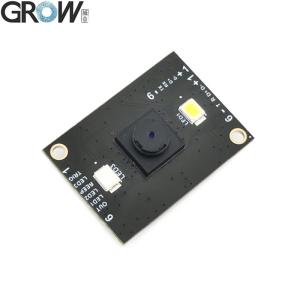
Description
1. USB wired barcode scanner to capture 1D, 2D code on labels,
paper, mobile phone or computer.
2. High-efficiency recognization and high upload speed for
improving your working efficiency.
3. With buzzer for reminding you that the scanning successfully or
not.
4. Compatible with UART interface.
5. Over 180 configurable options
6. Macro support replace a string in the bar code with another
7. Programmable preamble postamble and termination strings
8.Superior reading performance utilizing advanced decoding
algorithmsSpecifications
Parameter | Performance |
Sensor | CMOS |
Scan Mode | 640*480 |
Indicator Light | Green light as read successfully |
Read Code Type
| 1D: EAN-13, EAN-8, UPC-A, UPC-E ISSN, ISBN, CodaBar,Code 128,
Code93, ITF-14, ITF-6, Interleaved 2 of 5, Industrial 2 of 5,Matrix
2 of 5, Code 39,Code 11, MSI-Plessey,GS1 Composite,GS1-Databar (RSS) |
2D: QR Code, Data Matrix, PDF417 |
GM861
Reading Distance |
5-30cm
|
Contrast* | >25% |
Scan Angle** | Roll: 360° Pitch: 65° Yaw: 65° |
Viewing Angle | 67° (Horizontal) 53° (Vertical) |
Accuracy of reading* | ≥10mil |
Mechanical/electrical Parameters:
Parameter | Performance |
Interface | USB |
Size(mm) | External diameter: 28mm Internal diameter: 25mm
Height: 15mm Thread M25 |
Weight | 25 g |
Prompting Mode | LED Indicator |
Operating Voltage | 5V |
Operation Current | 70mA(Max) |
Standby Current | ≤6mA(Typical) |
Startup Time | ≤250mS (Typical) |
Environmental Parameters:
Parameter | Performance |
Operating Temperature | -20ºC~60ºC |
Storage Temperature | -40ºC~+100ºC |
Operating Humidity | 5%~95%(Non-Condensing) |
Environmental Light | Normal indoor light source |
Fall | Withstand 1.2 m drop on concrete floor (50 times 1.2 m drop on
concrete floor repeatedly) |
Files
·Provide User Manual
·CE CertificateSweep the dock, making convenience within reach
Driven by the wave of digitization, scanning technology has deeply
integrated into every aspect of our lives, and scanning recognition
modules, as the core force of this technology, are silently yet
powerful, making convenient life within reach.
The scanning recognition module is a component with complete
independent barcode scanning and decoding functions, which can be
written into various industry application programs as needed. It is
compact in size and highly integrated, and can be flexibly embedded
into many devices such as mobile phones, tablets, computers,
printers, and assembly line equipment. According to the scanning
type, there are one-dimensional code modules and two-dimensional
code modules; Divided by light sources, there are laser modules and
red light modules. The laser module uses laser points and vibration
motors to form laser lines for scanning barcodes, but due to its
mechanical structure, it is relatively vulnerable; The red light
scanning module adopts LED light source and CCD photosensitive
element, which is more stable without mechanical structure and has
a low maintenance rate.
In the retail industry, scanning recognition modules are powerful
assistants for efficient management and convenient payment. The
self-service checkout machine in large supermarkets allows
customers to align the product barcode with the scanning window,
and the module quickly recognizes the information to complete the
settlement, greatly reducing queuing time. In the field of mobile
payment, whether it is street shops or large supermarkets, scan
code payment devices cannot do without it. Consumers can present
their payment code, and merchants can scan it to complete the
transaction, which is simple and fast.
In the medical field, scanning recognition modules ensure precise
management and security. Scanning drug barcodes during drug
management can quickly confirm information and avoid dispensing
errors. In terms of patient management, by scanning the QR code of
the electronic health card, doctors can quickly access patient
medical records, examination reports, and other information,
improving the efficiency of medical treatment and ensuring higher
quality medical services.
In industrial manufacturing, scanning recognition modules assist in
production management and quality control. Introduce fixed barcode
scanning modules on the production line to replace manual scanning,
accelerate information entry speed and scanning accuracy, and
improve production efficiency. By tracing product barcodes,
companies can monitor product quality throughout the entire process
and promptly identify and resolve issues.
The logistics industry is an important application scenario for
scanning recognition modules. In terms of material tracking, it can
record the real-time transportation status and location information
of goods, ensuring timely and accurate delivery of goods. In
warehouse management, scanning the barcode of goods can quickly
complete inbound, outbound, and inventory operations, improving
management efficiency and accuracy.
The service sector is also more convenient and efficient due to the
scanning recognition module. Tourist attractions, visitors can scan
the QR code of their tickets to quickly enter the park; Check in at
the hotel, scan the QR code on your ID card to complete
registration; In ticket sales, it is used for verifying and
managing tickets such as train tickets, plane tickets, movie
tickets, etc., to ensure sales efficiency and security.
The scanning recognition module has significant advantages.
Efficient and fast, able to accurately identify barcodes or QR
codes in a short period of time, suitable for different lighting
environments. Accurate and reliable, using advanced image
recognition technology and decoding algorithms, with automatic
error correction function to reduce manual input errors. Flexible
integration, connected to various devices through multiple
interfaces, supports multiple development languages and platforms,
facilitates customized development, and meets the needs of
different application scenarios.
Looking ahead to the future, with the development of technologies
such as the Internet of Things and artificial intelligence,
scanning and recognition modules will usher in new opportunities.
It will develop towards higher performance, smaller size, and lower
power consumption, and deeply integrate with other technologies to
achieve more functions. For example, combining with artificial
intelligence to intelligently analyze and process scanned content,
providing more valuable information for enterprises.
Scanning dock - the scanning recognition module is quietly changing
our way of life and work with its powerful functions and wide
applications, making convenience the norm of life and driving the
digital process of society forward.



















